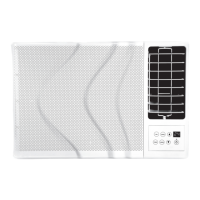PGD4, PGS4, Series G, H WPG4 Series D, H Ultra Low NOx: Installation Instructions
Manufacturer reserves the right to change, at any time, specifications and designs without notice and without obligations.
31
a. Ensure proper reassembly by marking wheel orientation.
b. Lift wheel from housing. When handling and/or cleaning blower
wheel, be sure not to disturb balance weights (clips) on blower
wheel vanes.
c. Remove caked-on dirt from wheel and housing with a brush.
Remove lint and/or dirt accumulations from wheel and housing
with vacuum cleaner, using soft brush attachment. Remove
grease and oil with mild solvent.
d. Reassemble wheel into housing.
e. Reassemble motor into housing. Be sure set screws are tightened
on motor shaft flats and not on round part of shaft. Reinstall
blower into unit. Reinstall capacitor.
f. Connect 5 pin plug and 4 pin plug to indoor blower motor.
g. Reinstall blower access panel (see Fig. 24).
3. Restore electrical power to unit. Start unit and check for proper
blower rotation and motor speeds during heating and cooling
cycles.
Induced Draft (combustion air) Blower Assembly
The induced-draft blower assembly consists of the inducer motor, the
blower housing, and the induced-draft blower wheel.
Clean the inducer wheel periodically to assure proper airflow and
heating efficiency. Inspect blower wheel every fall before the heating
season.
To inspect blower wheel:
1. Shut off power to the unit and close the manual shut off valve on
the gas supply line to the unit.
2. Remove 2 screws holding the flue hood (Fig. 22) and remove the
flue hood.
3. Remove flue baffle using a 5/16" ratchet to remove the 2 screws,
being careful not to drop the 2 screws into the inducer housing.
4. Wearing gloves, inspect the inducer wheel blades for cleanliness by
slowly spinning the wheel down using a screwdriver and observing
with a flashlight. If debris is evident on the blades, take a small
vacuum hose to the blades. Once you have cleaned 40 blades, the
process is complete.
NOTE: If a more thorough cleaning is required, refer to Service Manual
for removal of induced-draft blower assembly.
5. Re-connect the flue baffle using the 2 screws and 5/16" ratchet,
being careful not to drop the screws into the housing.
6. Re-connect flue hood (Fig. 22) using the 2 screws removed.
7. Turn power back onto unit and open gas supply shutoff valve.
Flue Gas Passageways
To inspect the flue collector box and upper areas of the heat exchanger:
1. Remove the induced draft blower assembly according to directions
in the service manual.
2. Remove the 11 screws holding the flue collector box cover (See
Fig. 23) to the heat exchanger assembly. Inspect the heat
exchangers.
3. Clean all surfaces, as required, using a wire brush.
Limit Switch
Remove blower access panel (see Fig. 24). Limit switch is located on the
fan partition.
Burner Ignition
Unit is equipped with a direct spark ignition 100 percent lockout system.
Ignition module (IGC) is located in the control box (See Fig. 23).
Module contains a self-diagnostic LED. During servicing, refer to label
diagram or Table 6 in these instructions for LED interpretation.
If lockout occurs, unit may be reset by either momentarily interrupting
power supply to unit or by turning selector switch to OFF position at the
thermostat.
NOTE: For Ultra Low NOx The combined flame sensor/sparker is
located on the right side of the burner box (See Fig. 22). The flame
sensor/sparker is accessible for service by removing the cover in the
right side panel. The burner thermal switch (BTS) is located on the top
of the burner box. For 60k heat sizes, the BTS switch is accessible
through the cover in the right side panel. For 90k heat sizes, the BTS
switch is accessible by removing the control access panel.
A200287
Fig. 22 – Burner Thermal Switch (BTS) (Ultra Low NOx)
A200278
Fig. 23 – Blower Housing, Flue Collector Box and Burner Heat
Exchanger Assembly (Ultra Low NOx)
Ultra Low NOx Burner Baffle Inspection/Cleaning (See
Fig. 23.)
If the inlet side of the burner is required to be inspected and cleaned for
trouble shooting, the design allow accessing the burner without
removing the burner box from the heat exchanger assembly. This can be
60k BTS
90k BTS
Sparker &
Flame Sensor
Sparker &
Flame Sensor
REMOVE SCREWS
BURNER BAFFLE

